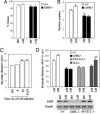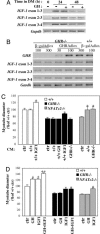Growth hormone promotes skeletal muscle cell fusion independent of insulin-like growth factor 1 up-regulation
- PMID: 16670201
- PMCID: PMC1456062
- DOI: 10.1073/pnas.0510033103
Growth hormone promotes skeletal muscle cell fusion independent of insulin-like growth factor 1 up-regulation
Abstract
Growth hormone (GH) participates in the postnatal regulation of skeletal muscle growth, although the mechanism of action is unclear. Here we show that the mass of skeletal muscles lacking GH receptors is reduced because of a decrease in myofiber size with normal myofiber number. GH signaling controls the size of the differentiated myotubes in a cell-autonomous manner while having no effect on size, proliferation, and differentiation of the myoblast precursor cells. The GH hypertrophic action leads to an increased myonuclear number, indicating that GH facilitates fusion of myoblasts with nascent myotubes. NFATc2, a transcription factor regulating this phase of fusion, is required for GH action because GH is unable to induce hypertrophy of NFATc2-/- myotubes. Finally, we provide three lines of evidence suggesting that GH facilitates cell fusion independent of insulin-like growth factor 1 (IGF-1) up-regulation. First, GH does not regulate IGF-1 expression in myotubes; second, GH action is not mediated by a secreted factor in conditioned medium; third, GH and IGF-1 hypertrophic effects are additive and rely on different signaling pathways. Taken together, these data unravel a specific function of GH in the control of cell fusion, an essential process for muscle growth.
Conflict of interest statement
Conflict of interest statement: No conflicts declared.
Figures





Similar articles
-
Distinct growth hormone receptor signaling modes regulate skeletal muscle development and insulin sensitivity in mice.J Clin Invest. 2010 Nov;120(11):4007-20. doi: 10.1172/JCI42447. J Clin Invest. 2010. PMID: 20921627 Free PMC article.
-
Growth hormone stimulates protein synthesis in bovine skeletal muscle cells without altering insulin-like growth factor-I mRNA expression.J Anim Sci. 2012 Apr;90(4):1126-33. doi: 10.2527/jas.2011-4358. Epub 2011 Nov 18. J Anim Sci. 2012. PMID: 22100600
-
Direct actions of growth hormone in rainbow trout, Oncorhynchus mykiss, skeletal muscle cells in vitro.Comp Biochem Physiol A Mol Integr Physiol. 2024 Nov;297:111725. doi: 10.1016/j.cbpa.2024.111725. Epub 2024 Aug 8. Comp Biochem Physiol A Mol Integr Physiol. 2024. PMID: 39122107
-
Growth hormone and the insulin-like growth factor system in myogenesis.Endocr Rev. 1996 Oct;17(5):481-517. doi: 10.1210/edrv-17-5-481. Endocr Rev. 1996. PMID: 8897022 Review.
-
Fusion with the fused: a new role for interleukin-4 in the building of muscle.Cell. 2003 May 16;113(4):422-3. doi: 10.1016/s0092-8674(03)00358-1. Cell. 2003. PMID: 12757701 Review.
Cited by
-
KMT5B is required for early motor development.Front Genet. 2022 Aug 12;13:901228. doi: 10.3389/fgene.2022.901228. eCollection 2022. Front Genet. 2022. PMID: 36035149 Free PMC article.
-
Identification and validation of novel contraction-regulated myokines released from primary human skeletal muscle cells.PLoS One. 2013 Apr 24;8(4):e62008. doi: 10.1371/journal.pone.0062008. Print 2013. PLoS One. 2013. PMID: 23637948 Free PMC article.
-
Endocrine parameters and phenotypes of the growth hormone receptor gene disrupted (GHR-/-) mouse.Endocr Rev. 2011 Jun;32(3):356-86. doi: 10.1210/er.2010-0009. Epub 2010 Dec 1. Endocr Rev. 2011. PMID: 21123740 Free PMC article. Review.
-
The Impact of Growth Hormone Therapy on the Apoptosis Assessment in CD34+ Hematopoietic Cells from Children with Growth Hormone Deficiency.Int J Mol Sci. 2017 Jan 7;18(1):111. doi: 10.3390/ijms18010111. Int J Mol Sci. 2017. PMID: 28067847 Free PMC article.
-
A multi-cohort study of polymorphisms in the GH/IGF axis and physical capability: the HALCyon programme.PLoS One. 2012;7(1):e29883. doi: 10.1371/journal.pone.0029883. Epub 2012 Jan 10. PLoS One. 2012. PMID: 22253814 Free PMC article.
References
-
- Florini J. R., Ewton D. Z., Coolican S. A. Endocr. Rev. 1996;17:481–517. - PubMed
-
- Hoffman A. R., Kuntze J. E., Baptista J., Baum H. B., Baumann G. P., Biller B. M., Clark R. V., Cook D., Inzucchi S. E., Kleinberg D., et al. J. Clin. Endocrinol. Metab. 2004;89:2048–2056. - PubMed
-
- Le Roith D., Bondy C., Yakar S., Liu J. L., Butler A. Endocr. Rev. 2001;22:53–74. - PubMed
-
- Shavlakadze T., Winn N., Rosenthal N., Grounds M. D. Growth Horm. IGF Res. 2005;15:4–18. - PubMed
Publication types
MeSH terms
Substances
Grants and funding
LinkOut - more resources
Full Text Sources
Molecular Biology Databases
Miscellaneous

